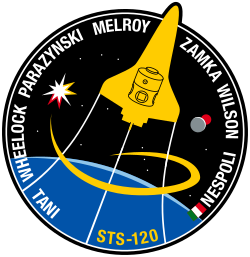Scott Edward Parazynski
| Scott Edward Parazynski | |
|---|---|
 Scott Edward Parazynski | |
| Astronaut NASA | |
| Státní příslušnost | |
| Datum narození | 28. července 1961 (63 let) |
| Místo narození | Little Rock, Arkansas |
| Předchozí zaměstnání | lékař |
| Čas ve vesmíru | 57 dní, 15 hodin a 34 minut |
| Kosmonaut od | 1992 |
| Mise | STS-66, STS-86, STS-95, STS-100, STS-120 |
| Znaky misí | |
| Některá data mohou pocházet z datové položky. | |
Scott Edward Parazynski (* 28. července 1961 v Little Rock, stát Arkansas, USA), americký lékař a kosmonaut. Ve vesmíru byl pětkrát. Zdolal také nejvyšší horu světa, Mount Everest.
Život
Studium a zaměstnání
Absolvoval střední školu Junior High School v senegalském Dakaru a libanonském Bejrútu a pak pokračoval ve studiu v Íránu na Teheran American School a v Libanonu na American Community High School. Po skončení středoškolské výuky v roce 1979 pokračoval ve studiu biologie na Stanford University, doktorát získal v roce 1989 na Stanford Medical School.
Tři roky pak pracoval jako lékař na pohotovosti v Denveru. Výcvik budoucích kosmonautů prodělal v Houstonu a v roce 1993 se stal členem jednotky kosmonautů NASA. Zůstal zde do roku 2009. V Houstonu pak zůstal jako řídící pracovník u společnosti Wyle Life Scientes.
Oženil se, jeho paní je Gail Marie, rozená Vozzellová.
Lety do vesmíru
Na oběžnou dráhu se v raketoplánech dostal pětkrát s funkcí letový specialista, pracoval na orbitálních stanicích ruské Mir i mezinárodní ISS.
Strávil ve vesmíru 57 dní, 15 hodin a 34 minut. Sedmkrát vystoupil do volného vesmíru (EVA), strávil v něm 47 hodin a 5 minut. Byl 318. člověkem ve vesmíru.
- STS-66 Atlantis (3. listopadu 1994 – 14. listopadu 1994)
- STS-86 Atlantis (25. září 1997 – 6. říjen 1997)
- STS-95 Discovery (29. říjen 1998 – 7. listopad 1998)
- STS-100 Endeavour (19. duben 2001 – 1. květen 2001)
- STS-120 Discovery 23. října 2007 – 7. listopadu 2007
Odkazy
Externí odkazy
 Obrázky, zvuky či videa k tématu Scott Edward Parazynski na Wikimedia Commons
Obrázky, zvuky či videa k tématu Scott Edward Parazynski na Wikimedia Commons - Na webu Space
- Na webu MEK-Kosmo
Média použitá na této stránce
Portrait of Dr. Scott Parazynski
STS-66 Mission Insignia
The STS-86 flight was the seventh shuttle-Mir docking mission, symbolized by seven stars. The international crew includes astronauts from the United States, Russia, and France. The flags of these nations are incorporated in the rays of the astronaut logo. The rays of light streaking across the sky depict the orbital tracks of the two spacecraft as they prepare to dock. During the flight, an American astronaut and a Russian cosmonaut will perform an extravehicular activity (EVA). The mercator projection of Earth illustrates the global cooperative nature of the flight.
Logo of Nasa's STS-100 mission.
- The STS-100/6A emblem reflects the complex interaction of robotics and extravehicular activity (EVA) on this mission. During the mission spacewalks will be conducted to deploy the International Space Station Remote Manipulator System (SSRMS). The EVA helmet frames the patch, with the Canadian-built SSRMS shown below the visor. Reflected in the visor is the Space Shuttle Endeavour, with the International Space Station rising above the horizon at orbital sunrise. Endeavour's payload bay houses a Spacelab pallet, itself holding the SSRMS and the Space Station Ultra High Frequency Antenna, and the Italian-built Multi-Purpose Logistics Module "Raffaello." American, Russian, Canadian, and Italian astronauts compose the crew, and their flags are stylized in the lower portion of the emblem. Ten stars adorn the sky, representing the children of the STS-100 crew and the future of space exploration.
The STS-95 patch, designed by the crew, is intended to reflect the scientific, engineering, and historic elements of the mission. The Space Shuttle Discovery is shown rising over the sunlit Earth limb, representing the global benefits of the mission science and the solar science objectives of the Spartan Satellite. The bold number '7' signifies the seven members of Discovery's crew and also represents a historical link to the original seven Mercury astronauts. The STS-95 crew member John Glenn's first orbital flight is represnted by the Friendship 7 capsule. The rocket plumes symbolize the three major fields of science represented by the mission payloads: microgravity material science, medical research for humans on Earth and in space, and astronomy.
The STS-120 patch reflects the role of the mission in the future of the space program. The shuttle payload bay carries Node 2, the doorway to the future international laboratory elements on the International Space Station. On the left the star represents the International Space Station; the red colored points represent the current location of the P6 solar array, furled and awaiting relocation when the crew arrives. During the mission, the crew will move P6 to its final home at the end of the port truss. The gold points represent the P6 solar array in its new location, unfurled and producing power for science and life support. On the right, the moon and Mars can be seen representing the future of NASA. The constellation Orion rises in the background, symbolizing NASA's new exploration vehicle. Through all, the shuttle rises up and away, leading the way to the future.






